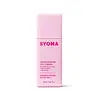What's inside
What's inside
 Key Ingredients
Key Ingredients

 Benefits
Benefits

 Concerns
Concerns

 Ingredients Side-by-side
Ingredients Side-by-side

Water
Skin ConditioningGlycerin
HumectantMethyl Methacrylate Crosspolymer
Propanediol
SolventPyrus Malus Fruit Extract
Skin ConditioningPentylene Glycol
Skin ConditioningPolymethylsilsesquioxane
Pseudoalteromonas Ferment Extract
HumectantNiacinamide
SmoothingBambusa Arundinacea Stem Extract
Skin ConditioningDimethicone
EmollientSalix Nigra Bark Extract
Skin ProtectingTamarindus Indica Seed Gum
Emulsion StabilisingSqualane
EmollientHydroxyacetophenone
AntioxidantIsononyl Isononanoate
EmollientHydroxyethyl Acrylate/Sodium Acryloyldimethyl Taurate Copolymer
Emulsion StabilisingAcrylates/C10-30 Alkyl Acrylate Crosspolymer
Emulsion StabilisingGlyceryl Citrate/Lactate/Linoleate/Oleate
EmulsifyingPotassium Hydroxide
BufferingCarbomer
Emulsion StabilisingGlyceryl Caprylate
EmollientGlyceryl Polyacrylate
Tocopherol
AntioxidantPolyglyceryl-3 Caprate
EmulsifyingPolyglyceryl-4 Cocoate
EmollientTrisodium Ethylenediamine Disuccinate
Polysorbate 60
EmulsifyingSorbitan Isostearate
EmulsifyingSodium Salicylate
Preservative1,2-Hexanediol
Skin ConditioningCaprylyl Glycol
EmollientWater, Glycerin, Methyl Methacrylate Crosspolymer, Propanediol, Pyrus Malus Fruit Extract, Pentylene Glycol, Polymethylsilsesquioxane, Pseudoalteromonas Ferment Extract, Niacinamide, Bambusa Arundinacea Stem Extract, Dimethicone, Salix Nigra Bark Extract, Tamarindus Indica Seed Gum, Squalane, Hydroxyacetophenone, Isononyl Isononanoate, Hydroxyethyl Acrylate/Sodium Acryloyldimethyl Taurate Copolymer, Acrylates/C10-30 Alkyl Acrylate Crosspolymer, Glyceryl Citrate/Lactate/Linoleate/Oleate, Potassium Hydroxide, Carbomer, Glyceryl Caprylate, Glyceryl Polyacrylate, Tocopherol, Polyglyceryl-3 Caprate, Polyglyceryl-4 Cocoate, Trisodium Ethylenediamine Disuccinate, Polysorbate 60, Sorbitan Isostearate, Sodium Salicylate, 1,2-Hexanediol, Caprylyl Glycol
Water
Skin ConditioningGlycerin
HumectantCaprylic/Capric Triglyceride
MaskingPentaerythrityl Tetraethylhexanoate
EmollientNiacinamide
SmoothingCeramide NP
Skin ConditioningCholesterol
EmollientPhytosphingosine
Skin ConditioningPolyglyceryl-3 Methylglucose Distearate
EmulsifyingStearic Acid
CleansingOleic Acid
EmollientLactic Acid
BufferingTromethamine
BufferingCamellia Sinensis Leaf Extract
AntimicrobialHydroxyacetophenone
AntioxidantCetearyl Alcohol
EmollientCarbomer
Emulsion StabilisingXanthan Gum
Emulsifying1,2-Hexanediol
Skin ConditioningWater, Glycerin, Caprylic/Capric Triglyceride, Pentaerythrityl Tetraethylhexanoate, Niacinamide, Ceramide NP, Cholesterol, Phytosphingosine, Polyglyceryl-3 Methylglucose Distearate, Stearic Acid, Oleic Acid, Lactic Acid, Tromethamine, Camellia Sinensis Leaf Extract, Hydroxyacetophenone, Cetearyl Alcohol, Carbomer, Xanthan Gum, 1,2-Hexanediol
 Reviews
Reviews

Ingredients Explained
These ingredients are found in both products.
Ingredients higher up in an ingredient list are typically present in a larger amount.
1,2-Hexanediol is a synthetic liquid and another multi-functional powerhouse.
It is a:
- Humectant, drawing moisture into the skin
- Emollient, helping to soften skin
- Solvent, dispersing and stabilizing formulas
- Preservative booster, enhancing the antimicrobial activity of other preservatives
Carbomer is a polymer of acrylic acid. Its main role is to create a gel consistency.
A high amount of carbomer can cause pilling or balling up of products. Don't worry, most products contain 1% or less of carbomer.
Glycerin is already naturally found in your skin. It helps moisturize and protect your skin.
A study from 2016 found glycerin to be more effective as a humectant than AHAs and hyaluronic acid.
As a humectant, it helps the skin stay hydrated by pulling moisture to your skin. The low molecular weight of glycerin allows it to pull moisture into the deeper layers of your skin.
Hydrated skin improves your skin barrier; Your skin barrier helps protect against irritants and bacteria.
Glycerin has also been found to have antimicrobial and antiviral properties. Due to these properties, glycerin is often used in wound and burn treatments.
In cosmetics, glycerin is usually derived from plants such as soybean or palm. However, it can also be sourced from animals, such as tallow or animal fat.
This ingredient is organic, colorless, odorless, and non-toxic.
Glycerin is the name for this ingredient in American English. British English uses Glycerol/Glycerine.
Learn more about GlycerinHydroxyacetophenone is antioxidant with skin conditioning and soothing properties. It also boosts the efficiency of preservatives.
This ingredient is not irritating or sensitizing.
Niacinamide is a multitasking form of vitamin B3 that strengthens the skin barrier, reduces pores and dark spots, regulates oil, and improves signs of aging.
And the best part? It's gentle and well-tolerated by most skin types, including sensitive and reactive skin.
You might have heard of "niacin flush", or the reddening of skin that causes itchiness. Niacinamide has not been found to cause this.
In very rare cases, some individuals may not be able to tolerate niacinamide at all or experience an allergic reaction to it.
If you are experiencing flaking, irritation, and dryness with this ingredient, be sure to double check all your products as this ingredient can be found in all categories of skincare.
When incorporating niacinamide into your routine, look out for concentration amounts. Typically, 5% niacinamide provides benefits such as fading dark spots. However, if you have sensitive skin, it is better to begin with a smaller concentration.
When you apply niacinamide to your skin, your body converts it into nicotinamide adenine dinucleotide (NAD). NAD is an essential coenzyme that is already found in your cells as "fuel" and powers countless biological processes.
In your skin, NAD helps repair cell damage, produce new healthy cells, support collagen production, strengthen the skin barrier, and fight environmental stressors (like UV and pollution).
Our natural NAD levels start to decline with age, leading to slower skin repair, visible aging, and a weaker skin barrier. By providing your skin niacinamide, you're recharging your skin's NAD levels. This leads to stronger, healthier, and younger looking skin.
Another name for vitamin B3 is nicotinamide. This vitamin is water-soluble and our bodies don't store it. We obtain Vitamin B3 from either food or skincare. Meat, fish, wheat, yeast, and leafy greens contain vitamin B3.
The type of niacinamide used in skincare is synthetically created.
Learn more about NiacinamideWater. It's the most common cosmetic ingredient of all. You'll usually see it at the top of ingredient lists, meaning that it makes up the largest part of the product.
So why is it so popular? Water most often acts as a solvent - this means that it helps dissolve other ingredients into the formulation.
You'll also recognize water as that liquid we all need to stay alive. If you see this, drink a glass of water. Stay hydrated!
Learn more about Water